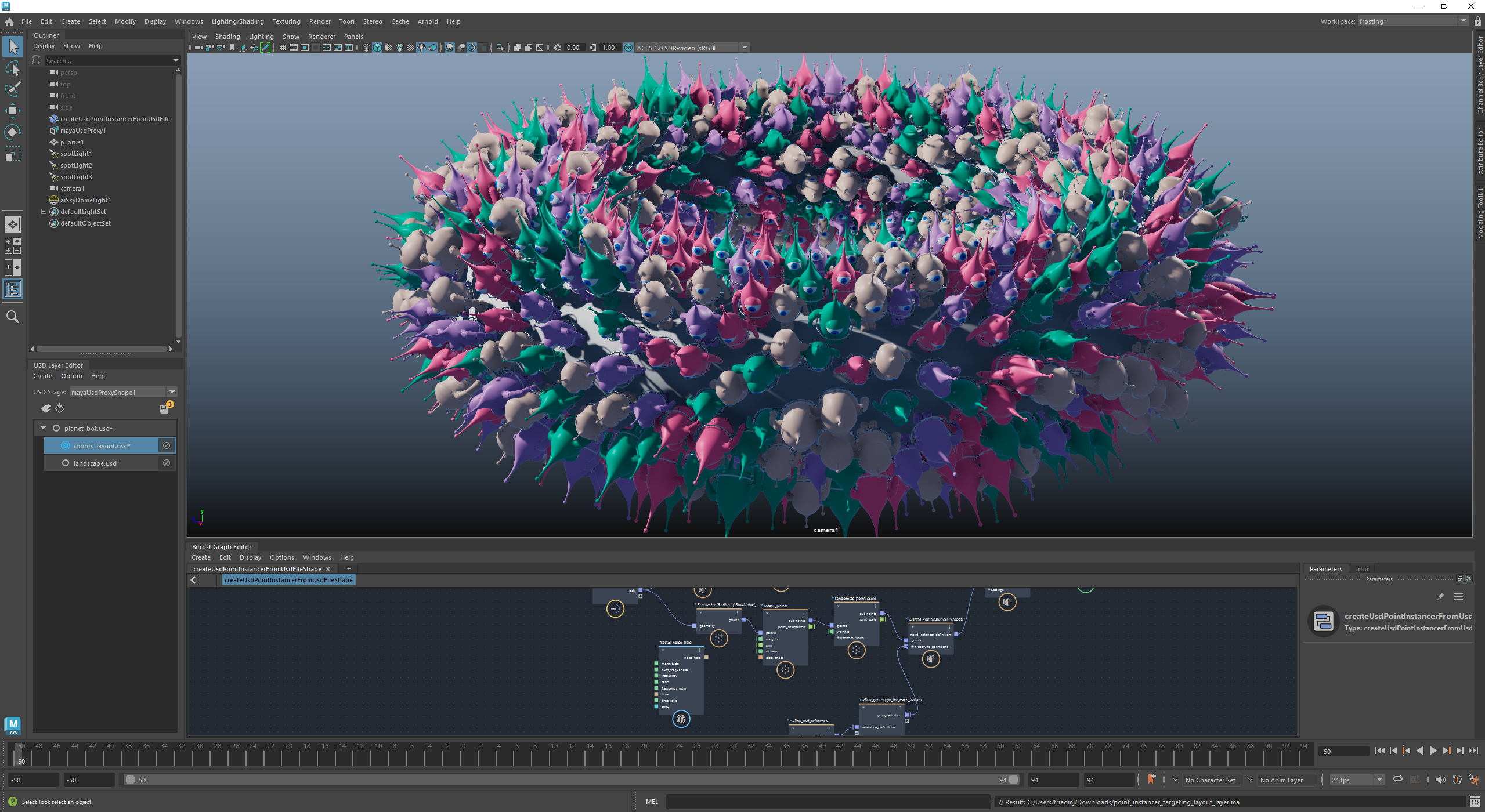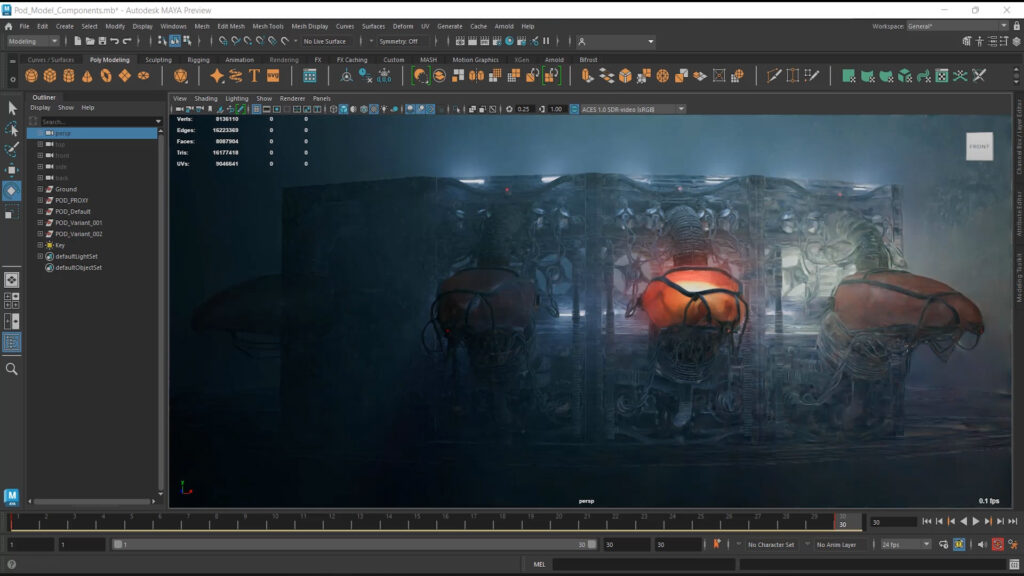
USD in Bifrost for Maya
Autodesk’s flagship Autodesk University event is coming up next week, bringing together innovators in architecture, engineering, construction, product design, manufacturing, media and entertainment, to share ideas, advance industry practices, and explore opportunities for the future.
The event includes several sessions related to open source software and standards, so we took some time to chat with Gordon Bradley, Autodesk Fellow to hear more about Autodesk’s open source involvement and his role in the Alliance for OpenUSD (AOUSD) as a Steering Committee Member.
Autodesk has released many open source projects over the years and is an active contributor to many others. Why is open source software important to Autodesk?

Gordon Bradley, Autodesk Fellow
Bradley: In the last decade, we’ve really seen the importance of open source technologies as a way of connecting data across our customer’s workflows—letting artists, creators, and designers use the best tools for the different jobs in their pipeline and enabling them to move data between different tools, departments, and companies while still preserving their design intent. We’ve also heard how important taking an open approach to data is for many companies—allowing them to access their data using open standard formats.
To provide the best support, we knew we wanted to build our products using the same open source projects our community uses. And to do that well, we knew we needed to get involved and contribute back where we could. We’ve been really lucky to contribute to some great projects over the last few years, including OpenColorIO, MaterialX, the newly announced OpenPBR, OpenVDB, and, of course, OpenUSD.
Why is USD as a technology important to Autodesk?
Bradley: There are lots of important open source projects, but USD is pretty unique in that it brings together the whole 3D scene. It includes really powerful data modeling and collaboration features like layers, variants, and composition, it’s extensible, and it comes with a rendering framework. Not only does this let us share complex 3D data sets between applications, but it opens the door for some really interesting collaboration workflows, data aggregation scenarios, and data visualization.
We’re already seeing USD transform the way entertainment pipelines are built, allowing studios to collaborate on data sets across artists using different tools, and share data sets between facilities. We knew we wanted to give studios deep USD support in products like Maya and 3ds Max, not only so they could export assets out as USD, but also enabling them to create, view, and edit USD natively. We wanted to bring together the tools and workflows artists love, with the performance, scalability, and collaboration features of USD.
Many of these challenges are not unique to entertainment, so it’s going to be really exciting to see where else USD makes sense in other industry workflows.
What were the drivers behind the formation of the AOUSD? Why now?
Bradley: Pixar has done such an incredible job developing USD and building the community around it. But with USD gaining traction in new domains, new industries, and on many new platforms, we really needed a way to take USD to the next level—to understand how we could scale USD to the broader set of scenarios, to get more people involved, and also to establish the formal standardization we’d need to bring USD into platforms like the web.
AOUSD was formed to promote the standardization, development, evolution, and growth of Pixar’s Universal Scene Description technology. The alliance seeks to standardize the 3D ecosystem by advancing the capabilities of OpenUSD. By promoting greater interoperability of 3D tools and data, the alliance will enable developers and content creators to describe, compose, and simulate large-scale 3D projects and build an ever-widening range of 3D-enabled products and services. Now more than ever, content creators need a cohesive way to collaborate and share data across tools, services, and platforms.

USD in Maya
What are some of the industry or technical challenges that the AOUSD hopes to address?
Bradley: The first goal we’re focusing on is establishing a formal specification for the core of USD, taking all the great things that USD does in code, and turning them into a formal standard we can all build upon. This is a really significant point in USD’s evolution, as it opens the door to integrating USD into new platforms and into industries where standardization is a prerequisite.
The core specification will give us the foundation to dig into lots of important topics, like getting USD well supported on web and mobile, tackling richer materials models, and adding support for new schema domains like BREPs.
But to do any of this well, we need to make sure we’ve got the right companies participating from the community. So definitely reach out to us if you’d like to get more involved!
Most of the Media & Entertainment industry relies on USD. Are you seeing it gain traction in other industries as well?
Bradley: The core challenges USD tackles are definitely not unique to entertainment. Whether you’re building CG worlds or digital twins or looking ahead to the 3D web, creators need a cohesive way to collaborate and share data across tools, services, and platforms. We’ve definitely seen interest from customers in other industries, which is really exciting.
But making a factory, a bridge, or a hospital introduces lots of new challenges we haven’t really looked at yet in USD. There are large ecosystems of existing standards and regulatory requirements, there are complex constraint engines, and there are new data types that don’t exist in the entertainment space. And that’s really the opportunity of USD outside entertainment: to understand where USD best fits into those workflows to enable new ways of working. We’re really looking forward to working with the industry to figure that out together.
For more information about the latest efforts in open source software at Autodesk, register for a free digital pass to Autodesk University.